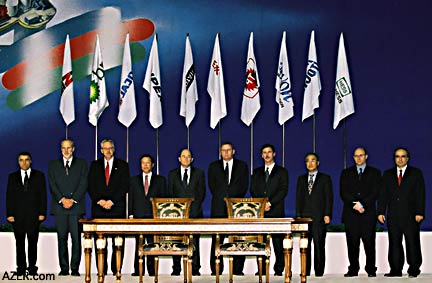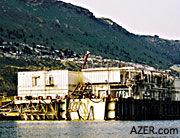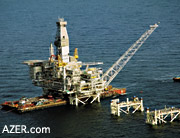|
Above: On October 16, 2004, the Golden Weld
Ceremony for the Baku-Tbilisi-Ceyhan (BTC) oil export pipeline
took place when the Presidents of the two host countries, Azerbaijan's
President Ilham Aliyev and Georgia's President Mickeil Saakashvilli
symbolically welded two pipeline sections together. Boyuk Kesik
village of Azerbaijan's Akstafa district bordering the Gardabani
district of Georgia. The Steering Committee for the
development of the Azeri, Chirag and deepwater portion of the
Gunashli (ACG) fields in the Azerbaijan sector of the Caspian
Sea, sanctioned in Baku on September 20 the construction stage
of the ACG Phase 3 project. The official signing of the Phase
3 project sanction resolution took place in a ceremony, which
was held at the Heydar Aliyev Respublika Palace as part of the
ACG Contract 10th Anniversary Celebration. Phase 3 sanctioning
is a major milestone towards full realization of the ACG Full
Field Development (FFD), which will ultimately deliver in excess
of one million barrels of oil per day. The Phase 3 project is
a $4.7 bn development plan. Some $3.2bn of the $4.7bn will be
spent on the construction of facilities, and the balance of the
sum will be spent on predrilling subsea injection wells, and
platform development drilling during the production period. Since the beginning of the year,
our production activities on Chirag have continued in accordance
with the plan for 2004 with an average production rate in excess
of 132,000 barrels per day for the full year, which significantly
exceeds our planned daily average production target of 125,000
for 2004, with an overall production efficiency of 93 percent
despite production cutbacks during January and February owing
to shipping congestion in the Turkish Straits and the planned
shutdown of the platform in early July.
Above: In October, four full sections of the Shah Deniz TPG 500 platform arrived in Baku, after a two-month journey from Singapore. They were successfully docked at the Floating Dry Dock by the Capsian Shipyard Company. Installation of Central Azeri Production, Drilling and Quarters (PDG). Topsides completed on October 10, 2004. The topsides of the Central Azeri Production, Drilling and Quarters (PDQ) Platform were successfully installed on the platform jacket offshore on October 10. It brought to reality a concept that was initiated five years ago. This followed the load out of the 15,000 ton-integrated deck onto the transportation barge STB-1 on the 3rd of October and sail away from the Heydar Aliyev Baku Deepwater Jackets Factory (BDJF) yard on October 8. The CA Topsides is a world-class facility fully built at BDJF in Azerbaijan. It has 48 well slots and 420,000 stock-tank barrels per day oil processing capacity with 122m x 50m x 34m dimensions. The living quarters of the platform will accommodate 200 people during production operations, which will begin early next year. Topsides construction employed more than 2,000 people at its peak, of which 75 percent were Azerbaijan citizens. In total the Deck construction and offshore installation activities for Central Azeri have expended 10 million man-hours with zero days away from work case (DAFWC). C&WP topsides Compressor and Water Injection Platform (C&WP) topsides fabrication in the ATA (AMEC-Azfen-Tekfen) yard in Bibi-Heybat is 82 percent complete and is on target for sailaway and offshore installation in the third quarter of 2005 and for the first gas injection in November 2005. The C&WP will be bridge-linked to CA PDQ and will provide all the gas and water injection to the Azeri field. A maximum of tengas injection wells, 12 water injection wells and two cutting injectionwells will be drilled on the Azeri field and the platform will have a final gas injection capacity of 1050 million cfd and water injection capacity of 900,000 bpd. All the subsea pipe-lay, tie-in and testing work for the oil and gas pipelines from Central Azeri to the Sangachal terminal is completed, along with installation and comissioning of the 187km fibre communications cable, which is now operational. The Pipe-lay barge Israfil Huseynov is currently completing its re-fit work, and will mobilise to commence the ACG Phase 2 pipe-lay work by the end of December. In October the pipe-lay barge was successfully used to support the Central Azeri hook-up, providing accommodation next to Central Azeri for 200 construction workers. Sangachal Terminal (STEP) The construction activities aimed at building one of the world's largest terminals are progressing on schedule. The main contractor of the STEP works, Tekfen/Azfen has achieved the 17 million hours milestone without any accident or injury from the beginning of the construction works in November 2001. This is a remarkable achievement and is a result of extremely hard work and dedication to safety of all the people involved. Overall construction works at STEP for Central Azeri are complete. The main completed works have included the installation of the major equipment and extensive piping systems. The pipelines have been successfully hydro tested and cleaned with the help of a pig. The construction of two crude oil tanks with a storage capacity of 880,000 barrels each is already complete and work is on schedule to complete a third tank in January 2005. The Shah Deniz Project The Shah Deniz gas and condensate development project has made significant progress during 2004 and Stage 1 construction is currently 44 percent complete overall. Construction works for Stage 1 are progressing according to schedule to meet the target of delivering first gas to the market before winter 2006. Following the successful three well pre-drill program and seismic re-imaging project during 2003-2004, BP has revised both our gas and condensate in place estimates and now believe there is an additional 20 percent of hydrocarbons in place across the whole field. Floating Dry Dock The four hull sections of the TPG 500 platform, which arrived in Baku following a two-month journey from Singapore in October, were successfully docked in the Floating Dry Dock by the Caspian Shipyard Company, the Shah Deniz contractor for the hull sections integration. The hull sections are currently being mated at the Floating Dry Dock to form the integrated deck. Work will continue on the hull integration until the end of March 2005, when the integrated hull is scheduled to be towed across the bay to the Zykh Yard for full topside integration and leg installation. All activities associated with the hull integration are progressing on schedule. Some 850 people are currently involved in these activities of which about 650 are Azerbaijan nationals. Zykh Yard Construction The Shah Deniz platform leg sections are under construction at the newly refurbished Zykh yard and are 37 percent complete. Some 1450 people are currently involved in the construction activities at the Zykh yard and of these 1200 are Azerbaijan citizens. Other ongoing activities at Zykh include the construction of temporary foundations, on which the legs will rest at the Zykh Quayside. This work is nearing completion in preparation for lifting into the water in February 2005. The Drilling Equipment Set (DES), which arrived in Baku from Norway in September, has already been assembled and is nearing mechanical completion. Commissioning of the facility commenced at the beginning of December. We will begin operator training on the commissioned facility prior to the skidding of the DES onto the hull in the second quarter of 2005, in addition, the Living Quarters and topsides pipe racks are undergoing a fit out process at the Zykh Yard. The overall construction of the platform is on schedule for sail away during the second quarter of 2006 in line with our target to achieve First Gas for the winter of 2006. South Caucasus Pipeline (SCP) The overall SCP project is 54 percent complete, with pipe stringing along the right of way 14 percent complete in Azerbaijan and 30 percent in Georgia. The mainline welding, which began in Azerbaijan in September is 10 percent complete, and in Georgia it is 21 percent complete. In Azerbaijan, the pipeline currently employs about 1085 people of whom 820 are Azerbaijan nationals. The SCP pipeline is scheduled to be completed in the fourth quarter of 2005. New Office Building BP, on behalf of its partners, recently signed an agreement with the local company Azinvest Property (related party to Azpetrol) for the development and the eventual lease of a new office building to be constructed by Azinvest. The office building will be constructed in Jalil Mammadguluzade Street on a plot of land, which covers about 26,000 sq metres. Azinvest will build the shell and core of the office premises and then lease the building to BP for its joint venture operations for a period of 15 years. The current design is four 4-5-storeyed interconnected blocks with about 500 parking spaces and other related facilities. The shell and core construction will commence in the first quarter of 2005 and should be completed by the third quarter of 2006. The BP staff hopes to begin moving into the new office in 2007 which will accommodate more than 1000 BP staff for the currently sanctioned projects operated by BP: the Azeri-Chirag-Gunashli (ACG), Early Oil Project (Phase 1, Phase 2, Phase 3), Shah Deniz Stage 1, South Caucasus Pipeline (SCP) and Baku Tbilisi Ceyhan (BTC). Back to Index AI 12.4 (Winter 2004) AI Home | Search | Magazine Choice | Topics | AI Store | Contact us Other Web sites created by Azerbaijan International AZgallery.org | AZERI.org | HAJIBEYOV.com |






